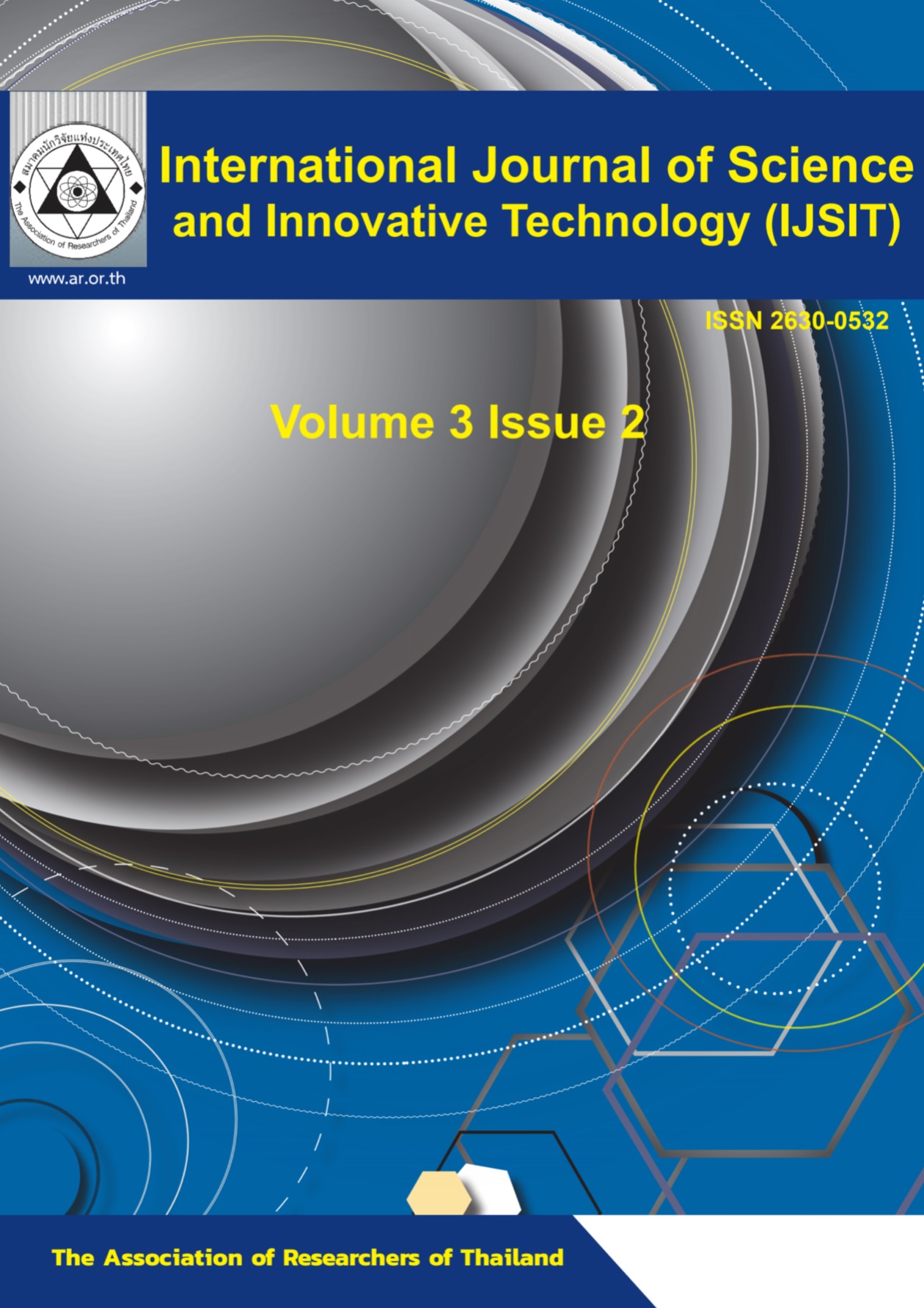The The Effects of Silica/Carbon Black Hybrid Filler Contents on Natural Rubber Composite Properties Using Conventional Vulcanization System
Main Article Content
Abstract
The physical properties and mechanical properties of rubber composite were improved by reinforcing with silica and carbon black (S/CB) hybrid filler. The amounts of S/CB hybrid filler were varied from 30 to 60 phr of NR and the good agreement between them was obtained. Maximum torque and minimum torque of NR compound grow continuously with increasing the amount of hybrid filler. When being vulcanized for 90 % of cure time at 150 °C, the physical and mechanical properties, e.g., hardness, volume change, abrasion loss, tensile strength, tensile modulus, elongation at break, tear strength and compression set of NR composite were investigated. The overall properties of the composite decreased after increasing S/CB hybrid filler of > 50 phr. This is mainly due to the agglomeration of S/CB hybrid filler. Moreover, hybrid filler content loaded NR composites hardly affects properties of aged NR composites.
Article Details
References
2. Pal, K., Rajasekar, R., Kang, D. J., Zang, Z. X., Pal, S. K., Das, C. K., Kim, J. K. (2010). Effect of fillers on natural rubber/high styrene rubber blends with nano silica: Morphology and wear. Mater. Des, 31, 677-686.
3. Schué, F. (2000). Blends of natural rubber. Novel techniques for blending with speciality polymers. Polym Int, 49, 472-472.
4. Nair, A. B., Joseph, R. (2014). Eco-friendly bio-composites using natural rubber (NR) matrices and natural fiber reinforcements. Woodhead Publishing Limited; Cochin University of Science and Technology, 249-283.
5. Al-Hartomy, O. A., Al-Ghamdi, A. A., Farha Al Said, S. A., Dishovsky, N., Mihaylov, M., Lvanov, M. (2016). Effect of the Carbon-Silica Reinforcing Filler Obtained from the Pyrolysis-Cum-Water Vapour of Waste Green Tyres upon the Properties of Natural Rubber Based Composites. J. Compos. Mater, 50, 377-386.
6. Flanigan, C. M., Beyer, L., Klekamp, D., Rohweder, D. (2012). Comparative study of silica, carbon black and novel fillers in tread compounds. Rubber World, 245, 18-31.
7. Kato, A., Ikeda, Y., Tsushi, R., Kokubo, Y. (2013). Viscoelastic properties and filler dispersion in carbon black‐filled and silica‐filled cross‐linked natural rubbers. J. Appl. Polym. Sci, 130, 2594-2602.
8. Rattanasom, N., Prasertsri, S., Ruangritnumchai. (2009). Comparison of the mechanical properties at similar hardness level of natural rubber filled with various reinforcing-fillers. T. Polym Test, 28, 8-12.
9. Rattanasom, N., Saowapark, T., Deeprasertkul, C. (2007). Reinforcement of natural rubber with silica/carbon black hybrid filler. Polym Test, 26, 369-377.
10. Ulfah, I. M., Fidyaningsih, R., Rahayu, S.; Fitriani, D. A., Saputra, D. A., Winarto, D. A., Wisojodharmo, L. A. (2015). Influence of carbon black and silica filler on the rheological and mechanical properties of natural rubber compound. Procedia Chem, 16, 258-264.
11. Li, Z. H., Zhang, J., Chen, S. J. (2008). Effects of carbon blacks with various structures on vulcanization and reinforcement of filled ethylene-propylene-diene rubber. Express Polym Lett, 2, 695-704.
12. Sae-Oui, P., Thepsuwan, U., Thaptong, P. (2014). Comparison of reinforcing efficiency of carbon black, conductive carbon black, and carbon nanotube in natural rubber. Adv Polym Tech, 33, 21422(1 of 7).
13. Thaptong, P., Sirisinha, C., Thepsuwan, U., Sae-Oui. (2014). Properties of natural rubber reinforced by carbon black-based hybrid fillers. P. Polym Plast Technol Eng, 53, 818-823.
14. Wang, Y., Liao, L., Zhong, J., He, D.; Xu, K., Yang, C., Luo, Y., Peng, Z. (2016). The effect of epoxidized natural rubber on mechanical properties of siliceous earth/natural rubber composites. J Appl Polym Sci, 133, 43571(1 of 9).
15. Xu, T., Jia, Z., Luo, Y., Jia, D., Peng, Z. (2015). Interfacial interaction between the epoxidized natural rubber and silica in natural rubber/silica composites. Appl Surf Sci, 328, 306-313.
16. Kralevich, M. L., Koenig, J. L. (1997). The effects of polyethylene glycol and the coupling agent bis-(γ-triethoxysilylpropyl)-tetrasulfide (Si-69) on the interactions of silica-filled natural rubber. Compos Interface, 5, 125-135.
17. Fröhlich, J., Niedermeier, W., Luginsland, H. D., (2005). The effect of filler–filler and filler–elastomer interaction on rubber reinforcement. Compos Part A Appl Sci Manuf, 36, 449-460.
18. Kaewsakul, W., Sahakaro, K., Dierkes, W. K., Noordermeer, J. W. M. (2014). Cooperative effects of epoxide functional groups on natural rubber and silane coupling agents on reinforcing efficiency of silica. Rubber Chem. Technol, 87, 291-310.
19. Kaewsakul, W., Sahakaro, K., Dierkes, W. K., Noordermeer, J. W. M. (2016). Factors influencing the flocculation process in silica-reinforced natural rubber compounds. J Elastom Plast, 48, 426-441.
20. Choi, S-S., Park, S. (2001). Silane grafted natural rubber and its compatibilization effect on silica-reinforced rubber tire compounds. Polym Kor, 9, 92-99.
21. Tabsan, N., Wirasate, S., Suchiva, K. (2010). Abrasion behavior of layered silicate reinforced natural rubber. Wear, 269, 394-404.
22. Smith, L. P. (1993). The language of rubber. Londpl: B9utterworth Heinemann.
23. Othman, A. B. (2001). Property profile of a laminated rubber bearing. Polym Test, 20, 159-166.
24. Ghari, H.S., Azam, J.A. (2016). Nanocomposites based on natural rubber, organoclay and nano-calcium carbonate: Study on the structure, cure behavior, static and dynamic-mechanical properties. Appl. Clay Sci, 119, 348-357.
25. Ramesan, M.T. (2004). The effects of filler content on cure and mechanical properties of dichlorocarbene modified styrene butadiene rubber/carbon black composites. J. Polym. Res, 11, 333-340.


